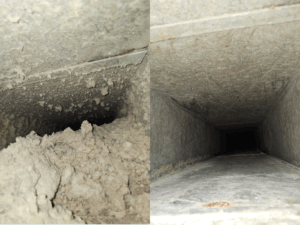Regular maintenance of ventilation systems is essential to ensure performance, air quality, and the health of occupants in a building. But how often should it be done, and what interventions are needed?
Inspections: A Critical Starting Point
It is recommended to inspect ventilation systems at least once a year. As stated in the official technical sheet from the Government of Quebec, “All mechanical ventilation systems must be inspected and adjusted at least once a year, and filters maintained or replaced as needed” (Frequence du Nettoyage des Conduits de Ventilation Mecanique, 2023).
This step allows you to check the overall condition of the ducts, the cleanliness of the filters, and the proper functioning of motors and ventilation grilles.
In high-traffic or specialized environments (restaurants, healthcare facilities, daycares), more frequent inspections (every 3 to 6 months) are strongly recommended.
This preventive technical visit helps detect signs of wear, dust buildup, or contaminants early, and makes it easier to plan necessary interventions before major issues or breakdowns occur.
📌 Also read: Commercial Ventilation: Costly Mistakes to avoid
Duct Cleaning: Keeping the Air Clean and Healthy
Over time, ventilation ducts accumulate dust, fibers, pollen, and sometimes even mold or grease residue (especially in kitchens). These deposits affect air quality and reduce system efficiency. Recommended frequency depends on the environment:

1. Standard business sectors (offices, retail stores)
Recommended duct cleaning frequency: every 3 to 5 years.
This helps maintain good air quality and prevents dust buildup.
2. High-traffic commercial buildings (clinics, schools, busy retail spaces)
Recommended duct cleaning frequency: every 1 to 3 years.
Due to intensive use and faster accumulation of dust and contaminants in ventilation ducts.
Periodic cleaning of your ducts not only improves the building’s energy performance, but also extends the system’s lifespan and reduces health risks for occupants.
When to replace ventilation system filters
Filters play a key role in trapping airborne particles and protecting system components. When clogged, they block airflow and overwork motors, which can lead to premature failure.
A strict filter replacement or cleaning schedule should be followed based on manufacturer recommendations and real usage conditions.
General replacement guidelines:
-
Every 3 to 6 months for standard systems in offices or commercial spaces
-
Every 1 to 3 months in high-pollution or high-occupancy environments (kitchens, food chains, medical facilities, etc.)
Conclusion
Proper maintenance, based on regular inspections, professional duct cleaning, and diligent filter replacement, ensures not only air quality and occupant comfort but also the long-term durability and performance of commercial ventilation systems.
Planning these interventions according to the building’s actual use and specific needs is the best way to prevent costly breakdowns and maintain a healthy environment.
See our ventilation cleaning and maintenance service page to learn more about our technical interventions.